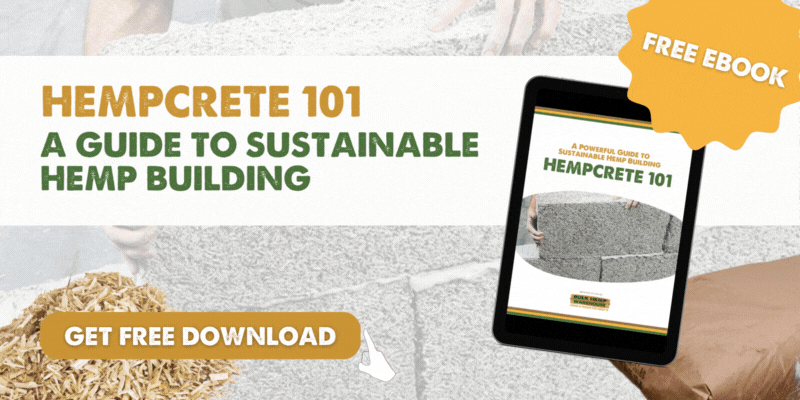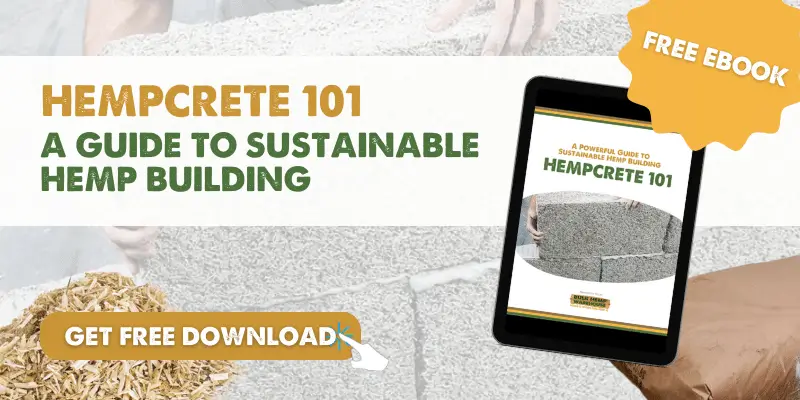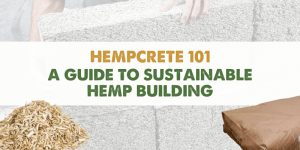
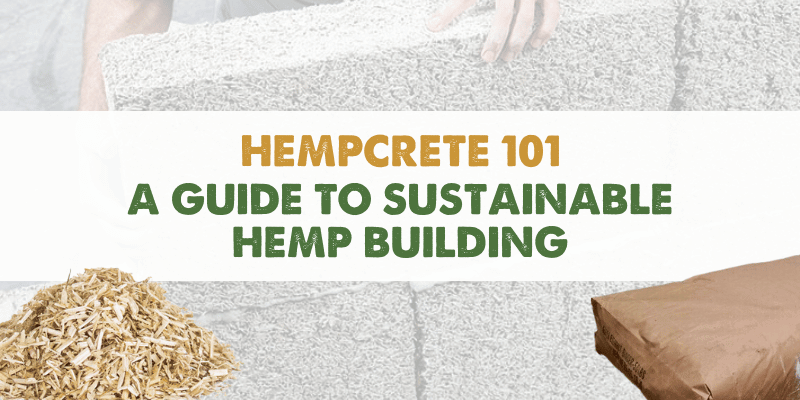
- Author Bulk Hemp Warehouse
- Categories: Hemp Benefits, Hemp Building
Hempcrete 101: A Powerful Guide to Sustainable Hemp Building
Welcome to your go-to guide for all things hempcrete.
It’s important to understand the meaning of hempcrete before we delve into its many applications.
In this comprehensive guide to hempcrete you will learn what it is, what it isn’t, the different ways to use it as well as some of the amazing benefits, as well as some of the disadvantages.
Lastly we will cover some of the most common questions around hempcrete. So bookmark this page for future reference, and let’s dive in!
What is hempcrete?
The definition of hempcrete is a combination of two words, hemp and crete.
Hempcrete vs Concrete
The hemp part refers to the cellulose-rich part of the hemp stalk known as hemp hurd fiber.
And the word crete is borrowed from the word concrete which means to grow together or solidify.
Hempcrete is an innovative, sustainable construction material made of industrial hemp and a lime-based binder. It offers a wide range of benefits which we will get into shortly.
Manufactured globally, you can find a vast network of hempcrete manufacturers in the USA and around the world to cater to your building needs.
Essentially, hempcrete is a building material used as an insulative dividing wall, but provides very little structural support.
Hempcrete insulation does have the potential be a load bearing material as well, with some additional compounds to help with that loadbearing aspect.
Which means you will still need to consider your framework and structure of your building.
What hempcrete is not.
However, as you will quickly learn hempcrete is NOT a replacement or substitute for concrete, as hempcrete is not a weight-bearing material.
Which is why some hemp building professionals refer to hempcrete as ‘hemplime.’

How is HempCrete Made?
A commonly asked question is, ‘how to make hempcrete?’.
The hempcrete recipe is straightforward and quite simple. Once you understand the hempcrete recipe you will know how to make hempcrete blocks or any other hempcrete based product.
First, you add hemp hurd (aka hemp shivs) from the stalk of the hemp plant and then you mix it with a lime-based hydraulic binder (although some builders prefer a non-hydraulic lime binder).
This mix is then poured into moulds, creating hempcrete blocks or hempcrete lego blocks, or a hempcrete wall.
There are blocks for sale from a few hempcrete manufacturers which are versatile and can be used in varied hempcrete insulation projects.
The hempcrete manufacturing process is environmentally friendly, contributing to hempcrete architecture’s overall sustainability.
It’s not likely that the average builder is going to make their own hemp bricks, but it can be done. The more likely scenario is the hemp bricks will be provided by a hemp brick maker.
For a full hempcrete recipe check out this infographic we made on how to mix hempcrete.
Starting with the hempcrete mixture, the recipe primarily revolves around three ingredients: hemp hurds, a binder, and water.
The hemp hurds, also known as shives, are the woody core of the hemp plant, which is a fast-growing and sustainable resource.
Then comes the all-important binder, the second component of the hempcrete mixture.
This is typically made from a combination of hydrated lime and pozzolans—the elements that, when mixed with water, lend firmness to the hempcrete.
Building with hempcrete involves a similar process to traditional construction.
Hempcrete walls are built with a wooden framework (which is adhered to the studs) and then filled with the hempcrete mixture.
As the hempcrete dries, it adheres to the frame, and the boards can then be removed exposing the hempcrete to better cure and dry out.
Now the hempcrete can provide excellent thermal insulation and creating homes that are cool in summer and warm in winter.
Properties of Hempcrete
Hempcrete in the USA, especially in Texas, California and Florida, has gained significant popularity in recent years among green builders and architects.
Hempcrete home builders and hempcrete architects think highly of this material because of its insulation properties and fireproof nature.
Yes, indeed, hempcrete is fireproof, which makes it an even safer building choice.
Another attractive feature is the relatively low hempcrete house cost compared to traditional construction.
While the cost of hempcrete may vary, according to the hempcrete market dynamics, the value it offers through energy-saving insulation and a healthier living environment justifies its slightly higher price tag compared to traditional building methods.
In other words, when you invest in hempcrete, you will ultimately be saving on energy bills and medical bills over the lifetime of your home.
Also, it’s important to mention that the thicker the walls the more insulative value will be created, making the energy efficiency and cost savings go up.
What is the R value of hempcrete?
Keep in mind that the R-value refers to the measure of resistance to heat flow through a given thickness of material. In simple terms, the higher the R-value, the better the insulation. The R-value of hempcrete stands at 0.8-1.2 per inch, which makes it a great insulator.
For those exploring the idea of building a hempcrete house, you can easily buy hempcrete from your nearest hempcrete manufacturers.
And for those DIY enthusiasts out there, exploring an adventurous project building with hempcrete, you can easily find hempcrete materials from suppliers, including hempcrete blocks for sale in the USA, or you can mix up your own slurry and poor the mixture into a framework you create yourself.
Hempcrete in Construction
Now let’s talk more about hempcrete construction. From hempcrete bricks to hempcrete lego blocks for sale, hempcrete provides a multitude of options. Hempcrete homes are also making a splash in Spain, and France where hempcrete construction is transforming the eco-friendly home landscape.

The Many Benefits of Hempcrete
The benefits of hempcrete far outweigh any drawbacks. Apart from the fact that hempcrete homes are environmentally friendly, they are also:
-
- Pest-resistant
- Fire-resistant
- Breathable, and
- Provide excellent thermal and acoustic insulation when compared to concrete
Having better acoustics means that with hempcrete walls you will dampen the sound, and therefore have a quieter home.
Check out local listings to find ‘hempcrete near me’ or connect with hempcrete home builders who can assist with your project, and even show you examples of hempcrete homes.
The future of building lies in sustainability, and hempcrete is leading the way. With an incredible mix of flexibility, resilience, and eco-friendliness, the era of hempcrete architecture and hempcrete projects is well upon us.
Hempcrete can be used as an eco-friendly substitute for insulation material in construction. Its unique properties give it an upper hand over common insulation materials.
The R-value of hempcrete demonstrates its ability to restrict heat flow, thus making your home energy efficient.
Whether you aim to buy hempcrete, discover the hempcrete details you need, or you are looking for a hempcrete factory, our robust network of hempcrete manufacturers in the USA is ready to cater to all your needs. Let’s build a greener future together with hempcrete.
Sustainability and Environmental Impact
Hempcrete is a sustainable building material that has a low carbon footprint and is biodegradable and recyclable. Hemp is a renewable resource that grows quickly and requires minimal water, pesticides, and fertilizers.
Additionally, hemp plants absorb carbon dioxide from the atmosphere during their growth, which helps reduce greenhouse gas emissions. When used in construction, hempcrete can sequester carbon and reduce the overall carbon footprint of the building.
Energy Efficiency and Insulation
Hempcrete is an excellent insulator, with a thermal conductivity of around 0.07 W/mK, which is lower than traditional building materials like concrete and brick.
This means that buildings constructed with hempcrete require less energy for heating and cooling, resulting in lower energy bills and reduced greenhouse gas emissions.
Hempcrete is also breathable, which allows moisture to pass through and prevents the buildup of mold and mildew. Additionally, hempcrete has a high thermal mass, which helps regulate indoor temperatures and reduce energy consumption.
Durability and Strength
Hempcrete is a durable and strong building material that is resistant to fire, pests, and mold. It has a low risk of cracking and can withstand seismic activity and extreme weather conditions.
Hempcrete also has a long lifespan and requires minimal maintenance, which reduces the overall cost of ownership. And in fact there are many hempcrete homes that have been standing for hundreds of years, in Europe.
Health Benefits of Hempcrete
Hempcrete is a nontoxic and hypoallergenic building material that does not emit harmful chemicals or volatile organic compounds (VOCs). It also has excellent indoor air quality and ventilation, which promotes comfort and wellbeing.
Limitations and Disadvantages of Hempcrete
Despite hempcrete’s many advantages, it is essential to keep in mind the limitations of hempcrete. As strong as hempcrete is for insulation, it’s not load-bearing, which is one of the few hempcrete disadvantages to consider.
Another small disadvantage is you do need to be careful when it comes to handling hempcrete due to the lime binder being used.
Lime can be quite caustic and corrosive, so it’s very important to wear protective gear while working with it, such as proper gloves and goggles to keep the dust off your skin and out of your eyes.
Another thing to consider is the upfront cost of investing in hempcrete. Although, as I mentioned, the long terms savings are worth the investment, you will need to come up with the capital to invest in the hemp hurd fibers and the lime binder, and with freight costs these days, it may seem like a lot upfront.
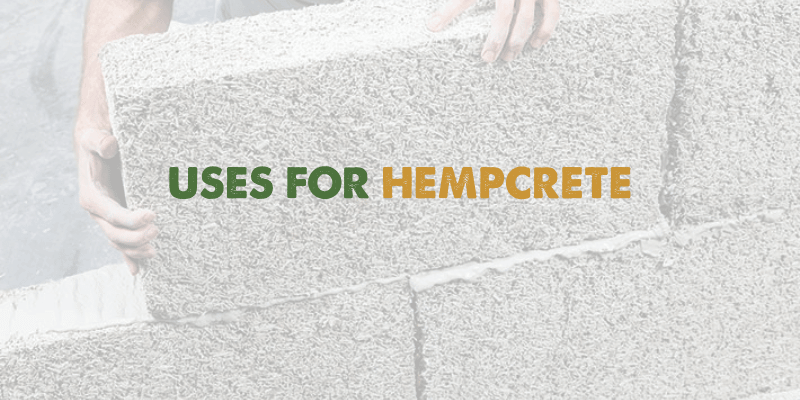
Hempcrete Compared to Other Building Materials
| Building Material | Cost per Square Foot | Environmental Impact | Ease of Use |
|---|---|---|---|
| Hempcrete | $10-$15 | High sustainability, renewable, CO2-absorbent and non-toxic | Moderately easy, requires special training |
| Brick | $10-$20 | High energy in manufacturing process, but long-lasting | Easy, commonly used |
| Concrete | $5-$25 | High CO2 emissions in production, but durable | Easy, commonly used |
| Wood | $10-$30 | Renewable, but involves deforestation | Very Easy, commonly used |
It’s important to note that prices for materials vary regionally and due to other factors like supply and demand the can fluctuate over time.
The environmental impact value is a bit simplified, as there are several factors that can contribute to each material’s impact.
ase of use is also a bit subjective and can depend on the skills of builder and the specific construction scenario.
But knowing that hempcrete is only three (3) materials mixed together, makes it pretty basic for almost anyone to learn how to do, with the help of an experienced hemp builder.
Hempcrete, while it has significant environmental benefits and reasonable cost, it is still a less common building material and may require builders trained in its use and applications.
If you’re looking for help finding a help builder, feel free to reach out, and we can put you in touch with someone local to your region.
What is hempcrete used for?
Hempcrete can be used in a variety of applications, including residential and commercial buildings, renovations and retrofits, and interior design.
Residential Buildings
Hempcrete is an excellent choice for residential buildings, including single-family homes, apartments, and townhouses.
It offers superior insulation and thermal performance, which reduces energy consumption and lowers heating and cooling costs.
Additionally, hempcrete is breathable, which helps regulate indoor humidity and prevents the buildup of mold and mildew.
Commercial Buildings
Hempcrete is also suitable for commercial buildings, including offices, retail spaces, and warehouses.
It provides excellent insulation and soundproofing, which creates a comfortable and quiet working environment.
Additionally, hempcrete is durable and low maintenance, which reduces the overall cost of ownership.
Renovations and Retrofits
Hempcrete can be used in renovations and retrofits of existing buildings, including insulation upgrades, wall and roof replacements, and interior design. =
It can be applied over existing walls and roofs, which reduces the need for demolition and construction.
Interior Design
Hempcrete can also be used for interior design, including wall finishes (with a lime-based scratch coat, and furniture – depending on how it’s used or crafted.
It offers a natural and organic aesthetic that is both beautiful and functional.
Practical Considerations for Building with Hempcrete
Building with hempcrete requires careful consideration of building codes and regulations, cost considerations, construction process and techniques, and maintenance and repair.
Building Codes and Regulations
Hempcrete must comply with local and national building codes and regulations, including fire safety, structural requirements, and energy efficiency standards.
It may also require certification and testing to ensure its performance and safety.
Refer to your architect or hempcrete builder for codes and regulations. They would know how to work with codes in your area.
Cost Consideration
Hempcrete may have a higher initial cost than traditional building materials, but it offers long-term savings in energy consumption and maintenance.
Additionally, the availability and sourcing of hempcrete may vary depending on location and market demand.
Construction Process and Techniques
Building with hempcrete requires advanced construction methods and techniques, including mixing and casting, formwork and reinforcement, and finishing and decoration.
It is essential to work with experienced hempcrete manufacturers and architects to ensure the proper installation and performance of the material.
There are several ways of applying or working with hempcere such as pouring into frameworks, using hempcrete panels, and using a spraycrete method.
Each one of these methods has it’s benefits and disadvantages, but the most popular method is the pouring into a framework method.
Hempcrete panels are a great concept if you’re doing large scale production and want to build many hempcrete homes at a time and are shipping the panels to the location to be put together.
The spraycrete method is the most difficult and messy approach, but can also make the process a little more speedy, and allows for some more customization.
Maintenance and Repair
Hempcrete requires minimal maintenance and repair, but it is essential to clean and upkeep the material regularly.
Repairing cracks and damages may require specialized techniques and materials, and renovations and additions may require additional planning and construction.
Also, it’s important to note that hempcrete is caustic to untreated metal.
So if you put hempcrete next to metal it needs to be painted or treated so the metal won’t come in contact with the lime binder.
Finding an Architect that will Build with HempCrete
Where Hempcrete is Being Used
One of the fascinating aspects of hempcrete is the various ways it can be used. The primary hempcrete uses cover construction of walls and buildings.
You can utilize hempcrete blocks or choose to cast hempcrete in situ to construct energy-efficient walls. The insulating properties of hempcrete make it an optimal choice for external walls, while its breathability makes it perfect for interior walls too.
One of the most extensive applications of hempcrete is in the construction of sustainable houses.
Hempcrete houses are not limited to a particular region or country but are sprawled across the U.S., Spain, and other parts of the world. Going beyond conventional building capabilities, these hempcrete homes are economical, efficient, and easy to maintain.
Not to mention, the cost of a hempcrete house is typically lower than its traditional counterparts, which adds to its appeal.
Beyond hempcrete walls to build homes, hempcrete blocks are gaining traction in various commercial hempcrete projects.
Whether it’s about remodelling a small office or building a large structure, architects are utilizing hempcrete blocks for enhancing thermal performance, reducing energy consumption, and achieving high acoustic insulation.
Hempcrete buildings stand testament to its versatility.
Be it for residential properties, commercial edifices, or renovation of old buildings, hempcrete can seamlessly blend into any architectural style.
The aesthetic appeal and energy efficiency of hempcrete buildings make them a popular choice for architects around the globe.
For those interested in integrating hempcrete into their construction plans, it is crucial to understand from where you can buy hempcrete.
Many hempcrete manufacturers in the USA and globally offer products ranging from precast hempcrete blocks to hempcrete binder.
For the DIY crowd, it is easy to buy these materials and explore hempcrete building techniques, perhaps starting with a small shed or a garden wall.
Where to Buy Hempcrete
Let’s delve into more specifics about building with hempcrete, its cost, and where to find hempcrete products.
If you’re looking for the hemp hurd fibers for hempcrete you can find that on this page here, and for the hempcrete binder visit this page here.
But what about the cost of hempcrete? And how does it compare with other construction materials?
Here’s the deal: while the cost of hempcrete blocks might be higher upfront than traditional concrete, the long-term benefits like durability, lower utility bills, and reduced maintenance costs make it financially attractive.
And for those thinking about the DIY route, you might be wondering, “Where can I buy hempcrete blocks?”
There are a few hempcrete manufacturers in the U.S., including in Florida, Texas and Canada. You can also look online for “hempcrete blocks for sale, USA”, or search “hempcrete near me” to find local retailers.
A few Other Points on the Topic of Hempcrete
Moreover, the burgeoning interest in hempcrete architecture has paved the way for the development of hempcrete products like hempcrete bricks and hempcrete lego blocks.
These products are versatile and can be moulded according to specific construction needs.
As the buzz around hempcrete continues to grow, several hempcrete projects are breaking ground not only in the U.S. but globally.
These projects are showcasing the potential of hempcrete as a sustainable building material and are also attracting investment into hempcrete manufacturing.
In conclusion, hempcrete, despite some minor drawbacks, offers a plethora of benefits that make it a promising option for those venturing into sustainable construction.
Whether you want to start a small hempcrete project or you are looking to build your dream hempcrete home, the first step is to connect with local hempcrete manufacturers or suppliers of hempcrete raw materials (like us here at Bulk Hemp Warehouse) to provide you with quality materials at competitive prices. Or if you’re feeling adventurous, you can try your hand at learning how to make hempcrete on your own.
Whatever your hempcrete needs may be, it’s clear that this sustainable material holds the future for green construction and design. Dare to dream big and build better with hempcrete!

Hempcrete Most Common Questions
It’s a mixture of hemp hurd fiber, lime binder, and water, that is used as an eco-friendly, sustainable insulating building material.
No. It is not a load-bearing building material, but strictly used for insulation purposes, and is not a replacement for concrete.
There are many benefits and advantages to using hempcrete, namely, it’s eco-friendly, sustainable, low carbon-footprint, easy to work with, saves you money, is healthier and looks pretty cool too!
It’s not a load-bearing material, requires a bit of education before working with, can have a higher upfront cost and can be a little tricky to work with if you don’t have experience.
Yes. However, please check with your local building inspector and make sure that hempcrete is allowed to be used as a building material in your area.
The upfront cost of working with hempcrete can be more than working with standard building materials, but the energy and health cost savings you will get over time makes this a very smart investment in your health, as well as financially saving you money over time.
Conclusion: The Future of Sustainable Building with Hempcrete
In conclusion, hempcrete, with its impressive catalog of attributes, is steadily winning the hearts of eco-conscious architects, builders, and homeowners.
The mixture’s adaptability and the multiple uses it offers make it a solution for many of today’s sustainability challenges.
Whether you intend to build hempcrete walls or intend to construct an entire hempcrete building, this green alternative is a worthwhile investment.
So, go ahead, discover your local manufacturer or supplier, and buy hempcrete to unlock the sustainable future of construction.
Hempcrete is an amazing building product that offers several benefits over traditional building materials. It is sustainable, energy-efficient, durable, and healthy, making it an excellent choice for affordable sustainable housing.
As more builders, architects, and homeowners discover the benefits of hempcrete, we can expect to see an increase in its use in construction and interior design.
With its carbon smart materials palette and amino acids protein, hempcrete is an absolutely essential building material for a sustainable future.
If you have any questions about hempcrete or where to buy hempcrete materials, our experienced team is happy to help you, reach out today with any questions you might have.
Or if you’re ready to get a quote for a project, send in your custom quote request here.
OTHER EDUCATIONAL HEMP POSTS
Explore Other Posts by Bulk Hemp Warehouse
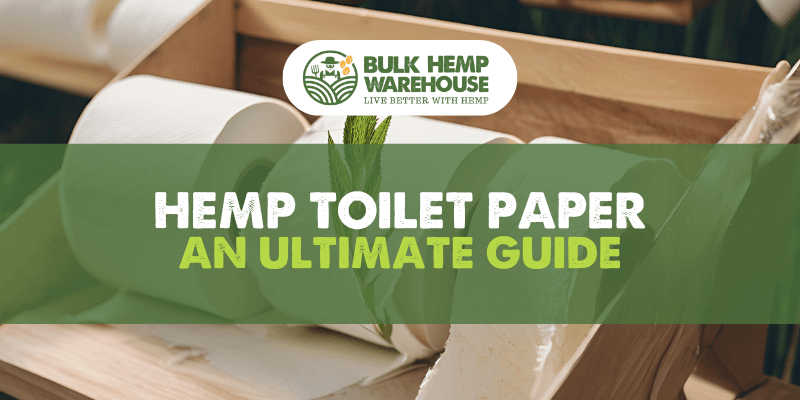
Hemp Toilet Paper: An Ultimate Guide
I’m certain that you’ve been thinking to yourself lately, why isn’t anyone selling hemp toilet paper? Have you ever thought about how toilet paper affects our planet, and all the trees being cut down? Hemp toilet paper could change the

The Nutritional Promise of Hemp Microgreens with LSU
Imagine stepping into a vibrant farmer’s market, where the air is rich with the smell of fresh greens. Amongst the array of colorful vegetables, you spot trays of delicate microgreens. What if I told you that one of these tiny

9 Creative Ways to Use Hemp Wick
DIscover these awesome 9 Creative Ways to Use Hemp Wick, other than just the typical lighting your herb application.


